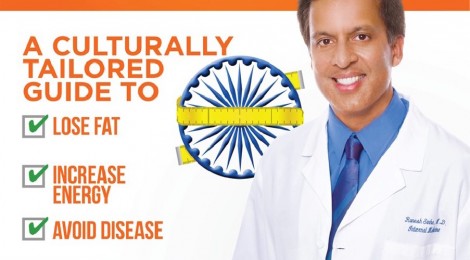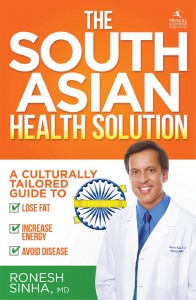
Book Review: The South Asian Health Solution
Every 4 years the Olympic games come around. And around this time there is chatter all around about how we Indians in spite of being the 2nd most populous country in the world get a tally of 4 or 5 medals at most, 4 of them being Bronze. The lone gold medal in the recent past was one by a shooter and not an athlete (not to belittle the feat in anyway).
Every few years the talk goes on as to how we will never win a medal because we’re not strong enough as compared to other races, we’re not fit enough, we don’t grow up eating the food they eat, we’re not ‘culturally’ inclined towards sport and so on and so forth.
When I first heard of the South Asian Health Solution on Mark’s Daily Apple, I was immediately excited. It’s written by Dr. Ronesh Sinha who is an internal medicine physician in California and has helped several high-risk South Asian patients find a solution by reversing heart disease (and other ailments) brought about by poor lifestyle choices.
In Dr. Sinha’s own words he says:
The South Asian audience reflects a population who is highly educated and highly productive, but surprisingly uninformed about healthy eating and lifestyle habits. This is particularly apparent in prevailing cultural trends such as intense academic experiences for children with insufficient attention and respect for fitness efforts and outdoor play.
One of the key features of this book is that it explains in detail how to modify cultural traditions that lead to weight gain and disease.
The reason why reading this excited me in the first place is because some of my most popular posts on this blog pertain to being vegetarian and paleo, the paleo lifestyle in the Indian context, paleo Indian recipes etc. These are also some of the most popular searches that lead to my blog.
Indians feel a sense of isolation when they stumble onto the primal lifestyle, see promise in it, but cannot figure out how to tailor it to our foods and our cultural stand point. Many write to me asking for day-to-day foods that they can eat; many find it too hard and give up. In this book the author writes about ghee instead of lard (what’s lard?) and talks about flavours and tastes closer to home to replace chapattis, daal, rice and overcooked sabzis instead of various parts of animal anatomies that I regularly need to decipher to figure out if my own diet is healthful enough.
This book bridges that gap between the ancestral way of eating and the current Indian diet, which is terribly high in carbohydrates.
Today Indians are some of the most sedentary, insulin resistant people on the globe, making India the capital for conditions like diabetes and heart disease, with heart attack onset often in the early 40’s.
Dr. Sinha has written about a low-insulin diet, or a diet that reduces insulin-stimulating foods. I think this is a fabulous idea. Currently all the blogs in the ancestral health sphere talk about cutting carbs and including a few foods that may or may not be technically paleo. Dr. Sinha points out specific foods cause insulin spikes and we should reduce this specially if we have any tendencies to be insulin resistant. (Which by the way most of us are).
A particular thought that stood out for me was that if you call a diet low-carb you’d be comparing it to NORMAL levels of carbs. As Indians we truly eat a HUGE excess of carbs and thus reducing them would not lead to low-carb but normalizing carb levels.
Dr. Ronesh Sinha in his book gives us some interesting tidbits about how we as a race got to be this way. He explains the thrifty genes theory whereby certain ethnic groups like South Asians used to live in year rounds feast-famine cycles inherited a gene that predisposed us to store body fat during times of famine. Today of course the feast-feast cycle coupled with sedentary lifestyles and poor diets causes our protective fat storage tendencies of our ancestors to produce an endemic of obesity, diabetes, and heart disease in the modern world.
This book is peppered with disturbing statistics like: The average South Asian person consumers 150-200 gms more carbs than do other ethnic groups.
Abnormal cholesterol results appear in South Asian almost 10 years earlier than they do in other ethnic groups.
Some things Dr. Sinha mentions are indeed a huge problem for us like:
Our vegetable intake is mostly from overcooked vegetables in a curry – with almost no additional raw or lightly cooked vegetables – which negates their anti oxidation qualities.
Even the South Asians who try and exercise do not include strength training, which is of utmost importance for men or women therefore many of us are ‘skinny fat’ and have absolutely no idea.
South Asian bodies are locked into a mode of constant fat storage due to the continued ingestion of high-carbohydrate meals that stimulate insulin production.
I particularly loved the chapters on South Asian women and children.
He talks about how thanks to our diets and cultural beliefs South Asian women are one of the highest at risk for PCOS and metabolic syndrome. – The overall global incidence is between 20 and 30 % where as studies show that the highest reported incidence in an ethnic group was amongst South Asian immigrants.
He writes about how cultural mindsets prevent pregnancies from being sufficiently active and healthy and how it affects our children by setting them up for diabetes and heart disease later on in life.
He brought alive a case study of a young boy of 8. While reading this I instantly though of the many mothers and kids I know. How our culture makes parents worry about the child not eating enough and giving them sweet or friend stuff just so that they look rotund and have a high weight without considering that chubbiness in a child post babyhood may not be ideal. He shared the story about a boy who was born slightly low birth weight and by the age of 8 had high triglycerides and a cholesterol panel.
As an Indian living in India I could see so many of my friends and family while Dr. Sinha was describing his case studies.
A friend who is in his early 30’s with all his blood results pointing to a disaster waiting to happen. He thinks the food he eats at home is healthy. Cooked in ‘barely any’ hydrogenated vegetable oil, includes no ghee or butter, overcooked vegetables, muesli for breakfast, lots of chapattis (without ghee of course).
The man on the street with his skinny arms and legs but a belly that is hard to miss.
A friend who has cut out all fats from her diet in order to lose weight to ‘cure’ her PCOS, but liberally eats chapattis and avoids egg yolks. She’s been trying for years to conceive without results.
The mothers of my son’s friends, forcing them to eat long after they’re done, and giving them anything just so they eat.
It has a section of recipes for chapatti’s and Indian food and is worth a look.
Though it is written keeping the Indian living in the US in mind, this book is written for us. It’s for all of us who want to be healthy, lose weight and have a long and happy life. Some of this stuff hits home and I would really recommend reading it to unlock our health potential.
Go buy it. (Link on the left panel)
Thanks for reading!





 Follow
Follow










Hi, Dr.Ron here. I’m flattered by this in depth book review. You truly highlighted some of the most critical points. I am thankful that South Asians have dedicated champions like Aloka deep in the heart of Mumbai, spreading the word on health using ancestral health principles. If you’ve ever had any doubts, I can assure you based on countless patients I see in the clinic, that this approach truly works. This blog is a tremendous resource and I look forward to referring more patients, family and friends here for information.
Thanks for the lovely comment Dr. Ron.
It’s a wonderful book and really good resource for those really wondering what they’ve been doing wrong.
read your post .. got me curious, ordered the book… cant wait to read..
great. i know you’ve been on the fence for awhile! maybe this will push you over:)
Hey Aloka just started reading ur blog! Can I mail u if I have any questions?
Hi please do 🙂
This is a brilliant book. I have just got into Paleo scheme of things to deal with my skin and pre-diabetes issus. Since going paleo for the past one week, my sugar levels have shown good progress. Thanks Aloka for this reference. I may send you an email for a discussion on Paleo in the future. Cheers the Paleo way !!